Embedded files (OLE objects)
You can embed a file in a Word document as an OLE object.
What is an OLE object?
OLE stands for Object Linking and Embedding. It’s a Microsoft framework that allows an application like Word to insert and interact with content from another application like Excel, PowerPoint, PDFs or even media players.
In Word, an OLE object uses that OLE framework to import content from an external file onto the document page, showing either the file's icon which can be double clicked on to open it up, or the external file's actual content shown in an OLE container. Here's what both look like on the page:
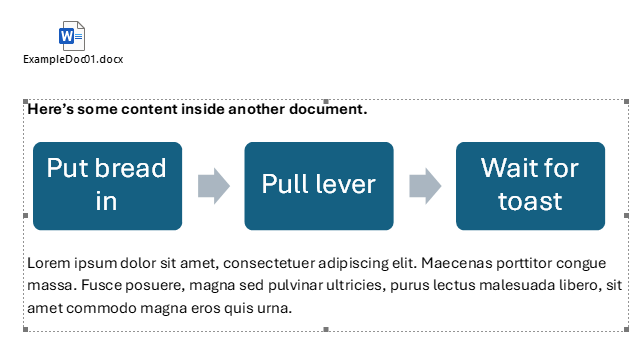
OLE objects are shown as either an icon or visual content of an external file, simple enough. However there are two different types of OLE object you can insert into a document and it's important to understand the difference:
- An Embedded OLE object stores content inside your Word document that becomes a static, self-contained copy/version of the source file, i.e. It doesn't update if the source file is changed.
- A Linked OLE object stores a reference in your Word document that connects to content within a source file. If the content in the source file changes, the linked OLE object updates in real time.
So which one should you go with?
On paper it sounds like the linked OLE object is better as it updates with the source file, but be warned — linked OLE objects are fragile; if the source file is moved, renamed, or deleted, then the link breaks.
Embedded OLE objects on the other hand are static; while they don’t update, they’re portable and safer for sharing.
You need to decide what is needed for your document. Do you need the external content/data displayed to be live? If so you'll want it linked. Or is the document complete, signed off, in a finished draft state for example and you need to display a copy of that specific version? If so you'll want it embedded.
Factors to consider
| Embedded OLE object | Linked OLE object |
|---|---|
| Document file size increases — the source file's file size is added onto your file. | File size isn't as affected because you're linking to content externally. |
| Can slow down the Word application and cause lag, especially in large documents. In some cases it may be wiser to link than embed. | Less likely to slow down the Word application. |
| Content is accessed within the document, it does not rely on access to an external file. | The user must have access to the same source file in order to view the content. |
| A Word document with an OLE object may not open correctly on other devices, OSs or platforms — think Mac, mobile, or web versions of Word. | |
Both embedded and linked OLE objects can trigger macro warnings or security prompts. Linked OLE objects can also produce warnings if source files are missing or inaccessible.
|
|
That's a lot of info, let's refresh:
| Behaviour | Embedded OLE object | Linked OLE object |
|---|---|---|
| Stored in document | Yes | No |
| File size impact | High | Low |
| Source updates when edited | No | Yes |
| Access | All within document | Requires additional access to source file |
| Format | File icon or content | File icon or content |
| Compatibility | Varies based on system | Varies based on system |
What files can I insert into an OLE object?
- Word - linked or embedded, icon or visual content
- Excel - as above
- PowerPoint - as above
- PDFs - as above
- Zipped files (in various formats: .zip, .7z etc) - linked or embedded, but cannot show visual content
- Audio and Video files - linked or embedded, but cannot show visual content
Inserting an OLE object
With OLE objects, whether embedded or linked in the document, the visual representation is either an icon or the external visual content itself. Here's how to insert both (Note: use this website's top left toggle to collapse the sidebar to see the following images more clearly):
Go to Insert > Object:
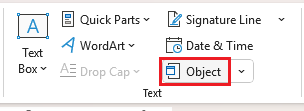
Next select the Create from File tab (the 'Create New' tab lets you choose between some formats first but it'll end up asking you to choose a file anyway). Click Browse and choose the external file you need:

Those two little checkboxes affect whether it will be displayed as an icon or visual content and whether it will be linked or embedded within this document:
| Icon - Embedded | Visual content - Embedded |
|---|---|
|
Before talking about which checkbox to check, the easiest way to embed a file with an icon is to just simply drag and drop an existing file icon into your open Word document and it'll embed itself on the page wherever your insertion point was when you dropped it.
But if you want to do it via Insert > Object, in this window check Display as icon, then click OK:
|
Leave both checkboxes unchecked, then click OK.
|
| Icon - Linked | Visual content - Linked |
|---|---|
|
Check both checkboxes Link to file and Display as icon, then click OK.
|
Check Link to file, then click OK.
|
Once inserted OLE objects look like this:
| Icon | Visual content |
|---|---|
|
|
|
What does each filetype look like?
| Filetype | Icon (linked or embedded) |
Visual content (embedded) |
Visual content (linked) |
|---|---|---|---|
| Word | 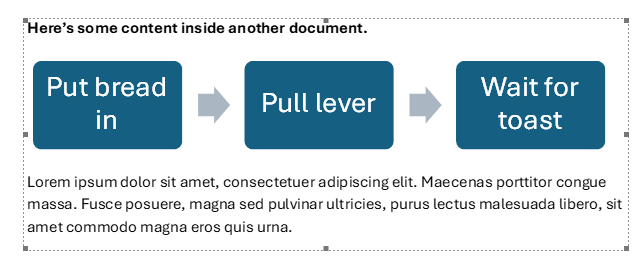 |
||
| Excel |  |
||
| PowerPoint |  |
||
| Outlook message |  |
 |
|
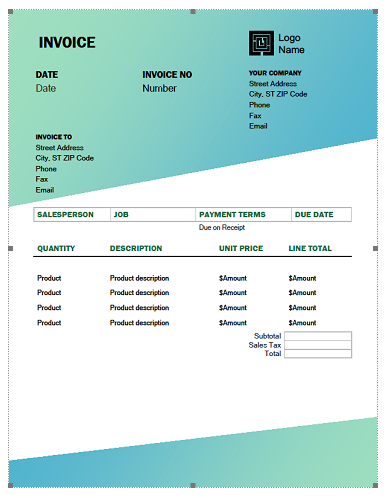 |
|||
| Zipped file |  |
 |
|
| Audio |  |
 |
|
| Video |  |
 |
|
| Other | As above | Depends on file | |
Opening an OLE object
To open an OLE object file (linked or embedded), simply double click on it and its respective application will open. With the example in this article I'm opening an embedded Word document — note the 'Document in Document1' title on the Quick Access Toolbar.

Why hasn't the OLE object content updated since I last edited the original/source file?
OLE objects only update with the source file if the content is linked to the source file. What you likely have is an OLE object with content previously imported from the source file, so the content at the time became embedded into the document; it won't update with the external source file as it's a separate past version of it. You'll want to delete this and create a linked OLE object instead.
- Understand the difference more: OLE object types
- How to insert the different types: Inserting OLE objects
Resizing an OLE object
Icons can't be resized, but visual content can. Select the visual content then click and drag the sizing handles at the edges of the OLE container to resize visual content on the page as needed.

Wrapping an OLE object
By default OLE objects are set to be in line with text. They behave slightly differently than images as they don’t expose the floating layout widget and require wrapping manually. To set wrapping for an OLE object right click on it then select Picture.

Select the Layout tab in the window that pops up. This give you some wrapping styles and alignment options but if you click Advanced it gives you a few more including the Top and Bottom style, and spacing from the surrounding text.
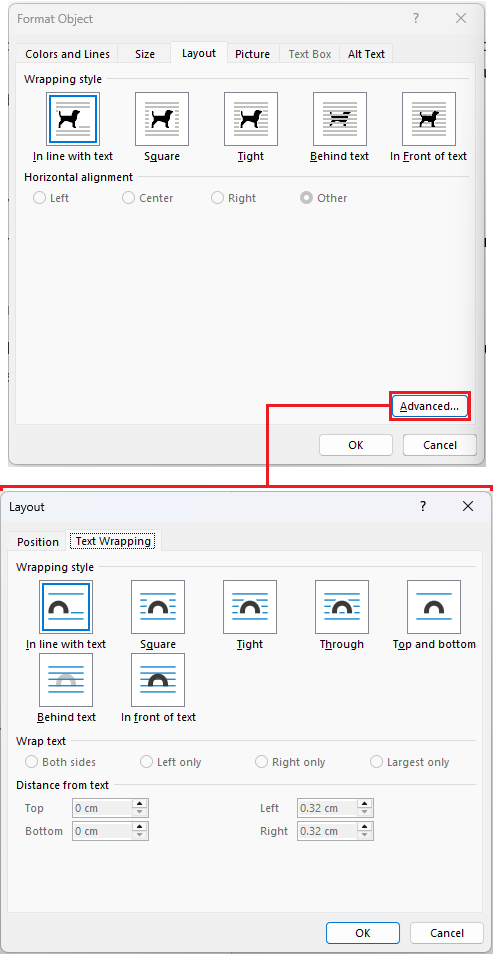
Here's the Top and Bottom wrapping style applied with some added 'distance from text' spacing top and bottom:




